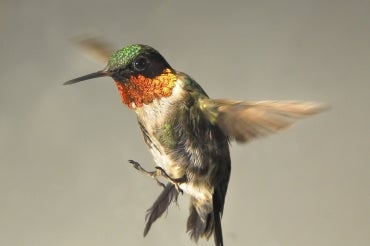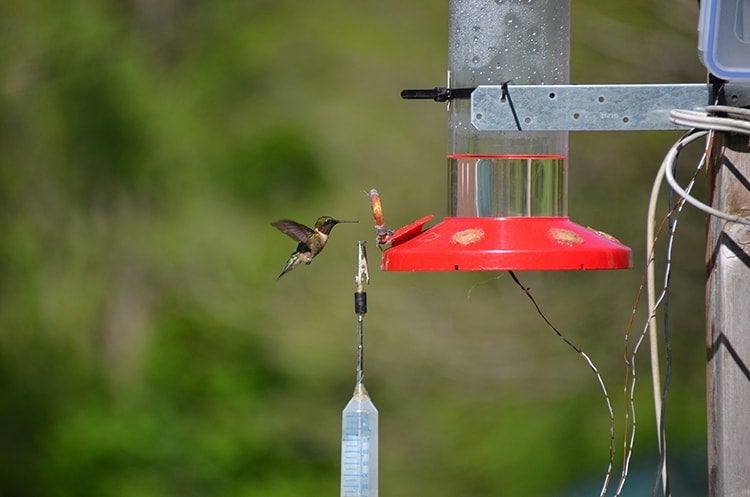Why some hummingbirds balloon up before they fly south: U of T research

Published: October 13, 2016
Some adult ruby-throated hummingbirds choose to pack on significant weight in the four days before their long migratory flights south for the winter, a new U of T study has found.
“Many different birds fatten up before they migrate, but we wanted to know what specific strategies hummingbirds use to fuel up prior to migration,” says Ken Welch, an associate professor of biological sciences at U of T Scarborough.
“It turns out that individual hummingbirds make individual decisions – some fatten up for long flights, while others stop and fuel along the way.”
Welch and master's student Lily Hou developed a unique system to track and weigh hummingbirds in the wild before migration using radio frequency identification tags. Every bird had a microchip and was weighed each time it landed on a balance attached to the feeder.
Hummingbirds that fatten up spent more time at feeders in order to gain weight rapidly, the researchers found – in some cases putting on as much as 35 to 40 per cent of their body mass in the four days before migration. They also found that no juvenile birds were fattening, meaning that those choosing to spend more time at feeders had made the migratory trip at least once.
“This suggests fattening could be a learned behaviour,” says Welch.
The findings add to a growing body of research that suggests pre-migration strategies for some birds are affected by age and experience, he says.
Birds generally use two strategies when it comes to preparing for migration. One prioritizes fattening to allow a more direct flight in order to arrive at the wintering grounds quickly. The other involves shorter flights, stopping and feeding along the way.
There are advantages to both, notes Welch. Short trips can be a safe strategy as long as resources can be found reliably along the way, but it can take longer to arrive at the final destination. For other birds, fattening may be necessary to take longer flights over large ecological barriers like oceans or deserts.
“The reason some hummingbirds fatten up before their long flight may be to gain an advantage over potential rivals – by arriving at their wintering grounds in southern Mexico and Central America quickly they can establish territories and control the best resources,” he says.

(hummingbird approaching a feeder, photo by Ken Welch)
During breeding season, hummingbirds generally only increase their eating activity in the evening before fasting for the night, while reducing it in the middle of the day. But the hummingbirds that fatten for migration tended to increase their eating activity during midday and the early evening.
Read more about Welch’s research
Welch’s past research found that hummingbirds can fuel their highly energetic hovering flight by burning both glucose and fructose, but he says it’s important to remember these are migratory birds and that carbohydrates alone are not enough.
“Migration is powered by fat. It’s extraordinary that hummingbirds can burn sugar to sustain their high metabolic rate, but it’s also amazing to think they can switch and do the same thing using just fat,” he says.
“The ability to switch between these fuels and to take sugar in, to build fat rapidly, underlines how flexible their metabolism is in addition to being supercharged.”
The study, which received funding from the National Geographic Society and the Natural Sciences and Engineering Research Council (NSERC), is available online in the journal Animal Behaviour.



